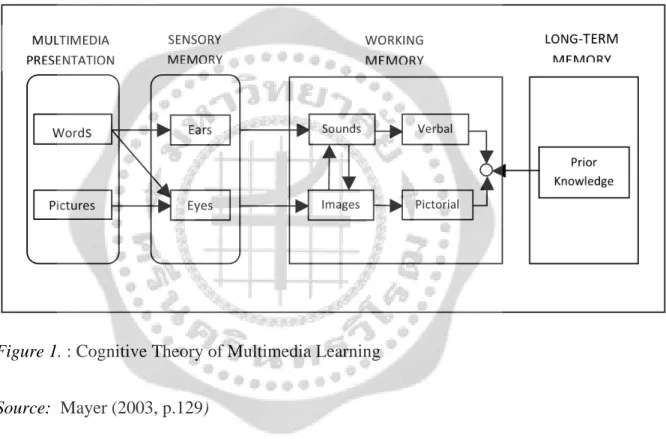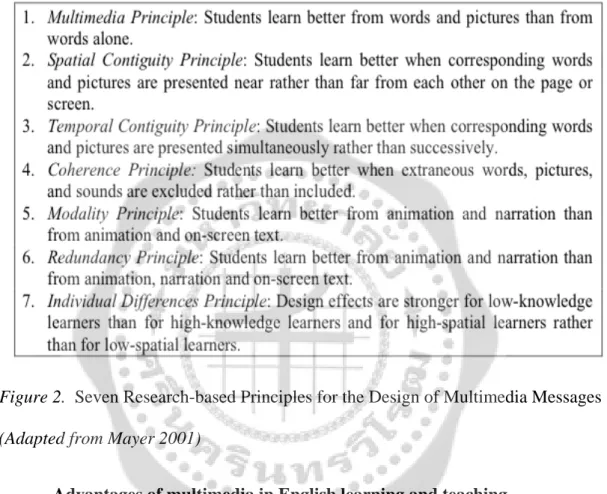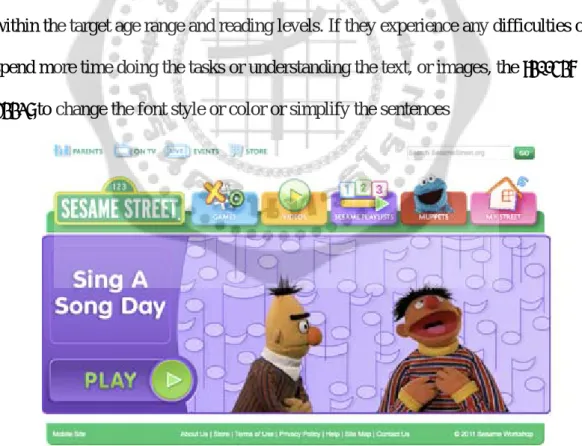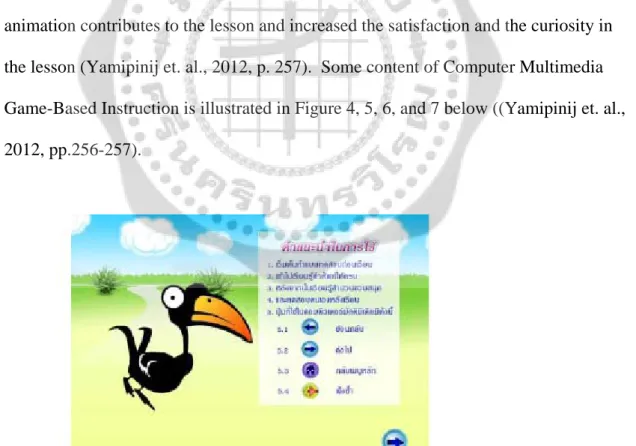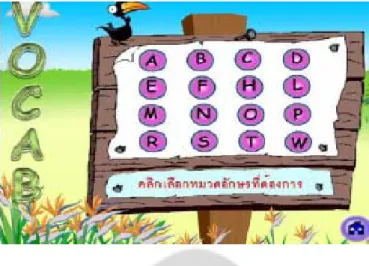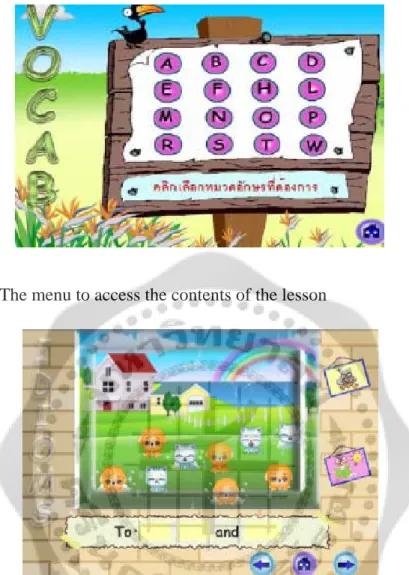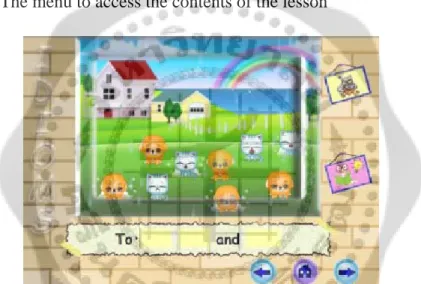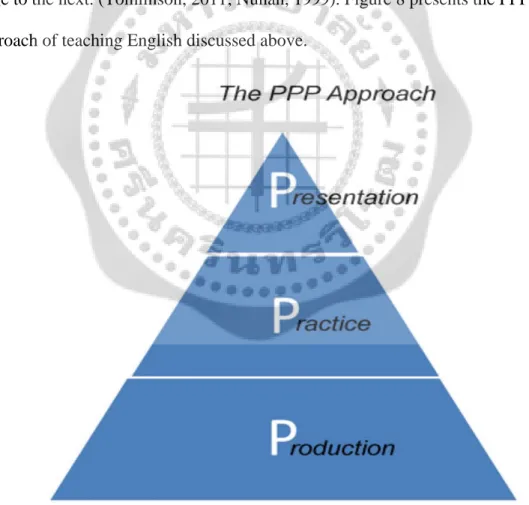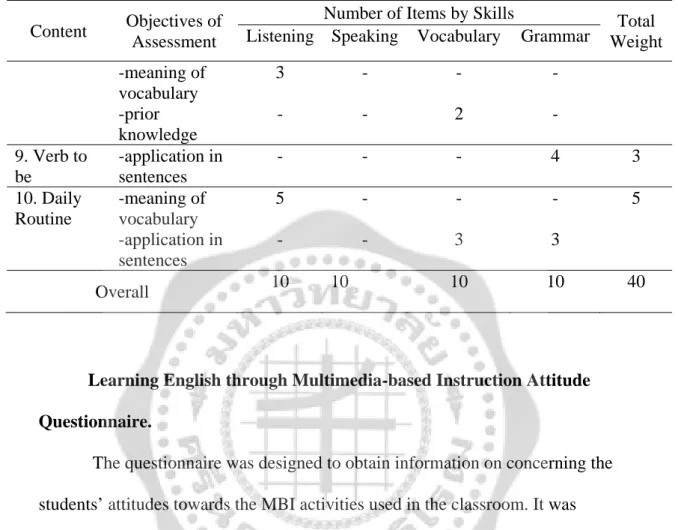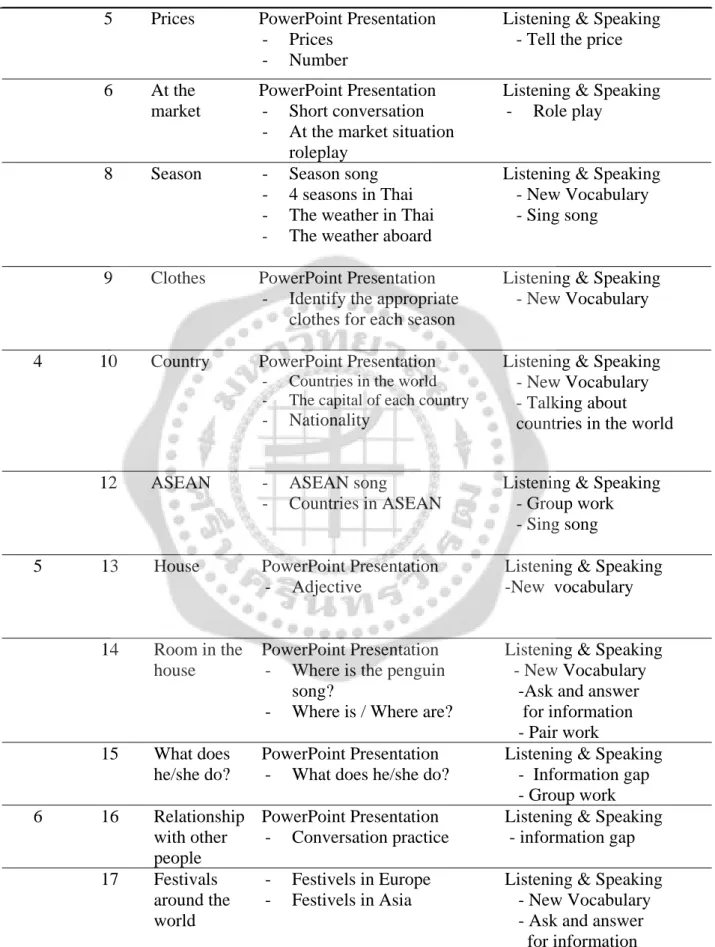A THESIS BY
PUDSADEE KAEWCHAWEE
Presented in Partial Fulfillment of the Requirements for the Master of Arts Degree in Teaching English as a Foreign Language
at Srinakharinwirot University May 2013
Copyright 2013 by Srinakharinwirot University
AN ABSTRACT BY
PUDSADEE KAEWCHAWEE
Presented in Partiail Fulfillment of the Requirements for the Master of Art Degree in Teaching English as a Foreign Language
at Srinakarinwirot University May 2013
Graduate School, Srinakharinwirot University. Adviser: Dr. Walaiporn Chaya.
The study aimed to investigate the effectiveness of Multimedia-Based Instruction to develop the sixth grade English ability. It also examined the students’
attitudes in learning English after taught through Multimedia-Based Instruction. The research design was one single group pre-test and post-test design. The participants of the study were fifty sixth grade students at Tessaban 1 Buriratdarunwittaya School, Buriram province. Data were collected through English ability pretest and posttest in four skills; listening, speaking, vocabulary and grammar, and learning English through Multimedia-Based Instruction attitude questionnaire. In the experiment, the students learned English through various Multimedia-Based Instruction activities for eight weeks. The Multimedia-Based Instruction included twenty-six lesson plans; each lesson plan was taught for three sessions and each session lasted 50 minutes. The results revealed the significant difference at the .01 level in the overall mean scores of the pre- test and post-test in the experimental group. In addition, the mean scores of the English ability pretest of the experiment goup was higher then that of the pretest. Furthermore, when comparing the mean scores between each skill, the results revealed that the mean scores of all skills of the pretest were higher than those of the posttest. Additionally, the results from the questionnaires revealed that students had highly positive attitudes toward learning English through Multimedia-Based Instruction. Also, the results from the open-ended questionnaires revealed that students enjoyed learning English through Multimedia-Based Instruction. This might be because the PowerPoint presentation, video clips from the websites helped them to enjoy learning English. Besides, students
บทคัดย่อ ของ ผุสดี แก้วฉวี
เสนอต่อบัณฑิตวิทยาลัย มหาวิทยาลัยศรีนครินทวิโรฒ เพื่อเป็นส่วนหนึ่งของการศึกษา ตามหลักสูตรปริญญาศิลปศาสตรมหาบัณฑิต
สาขาวิชการสอนภาษาอังกฤษในฐานะภาษาต่างประเทศ
พฤษภาคม 2556
ภาษาอังกฤษในฐานะภาษาต่างประเทศ). กรุงเทพฯ: บัณฑิตวิทยาลัย
มหาวิทยาลัยศรีนครินทรวิโรฒ. อาจารย์ที่ปรึกษาปริญญานิพนธ์: อาจารย์ ดร. วไลพร ฉายา
จุดประสงค์ของงานวิจัยในครั้งนี้เพื่อต้องการศึกษาประสิทธิผลของการสอนแบบสื่อประสม ในการพัฒนาความสามารถทางภาษาอังกฤษของนักเรียนชั้นประถมศึกษาปีที่ 6 นอกจากนี้ผู้วิจัย ต้องการศึกษาทัศนคติของนักเรียนที่มีต่อการเรียนภาษาอังกฤษด้วยสื่อประสม หรือสื่อมัลติมีเดีย แบบแผนการวิจัยเป็นแบบกลุ่มทดลองกลุ่มเดียววัดผลก่อนและหลังการทดลอง กลุ่มตัวอย่างคือ นักเรียนชั้นประถมศึกษาปีที่ 6 จํานวน 50 คน โดยนักเรียนในกลุ่มตัวอย่างเป็นนักเรียนโรงเรียน เทศบาล 1 บุรีราษฎร์ดรุณวิทยา จังหวัดบุรีรัมย์ ระยะเวลาในการทดลอง 8 สัปดาห์ รวม 26 คาบเรียน ไม่รวมเวลาจากการทดสอบก่อนและหลังเรียน เครื่องมือที่ใช้ในการเก็บข้อมูลประกอบด้วย ข้อสอบ วัดความรู้ภาษาอังกฤษก่อนเรียนและหลังเรียน โดยเป็นข้อสอบเป็นข้อสอบใช้ทดสอบ 4 ทักษะคือฟัง พูด คําศัพท์ ไวยากรณ์ และแบบสอบถามทัศนคติของนักเรียนที่มีการเรียนภาษาอังกฤษโดยใช้สื่อ ประสม ผลจากการศึกษาพบว่า ในภาพรวมการใช้สื่อประสมหรือสื่อมัลติมีเดียในการพัฒนา
ความสามารถทางภาษาอังกฤษของนักเรียน คะแนนหลังจากการทดลองสูงกว่าก่อนการทดลองอย่าง
มีนัยสําคัญทางสถิติที่ระดับ .01 อย่างไรก็ตาม เมื่อนําผลคะแนนจากการก่อนการทดลองและหลังการ
ทดลองมาวิเคราะห์แยกเป็นรายทักษะ 4 ทักษะแล้วนํามาเปรียบเทียบกัน พบว่าคะแนนของนักเรียน
หลังการทดลองในแต่ละทักษะเพิ่มสูงขึ้นอย่างมีนัยสําคัญทางสถิติในทุกทักษะ นอกจากนี้ผลจาก
แบบสอบถาม พบว่านักเรียนสนุกกับการเรียนภาษาอังกฤษผ่านสื่อประสมหรือสื่อมัลติมีเดีย โดย
นักเรียนได้ให้ความเห็นว่าสนุกกับการเรียน อาจเป็นเพราะว่างานนําเสนอโดยคอมพิวเตอร์ และคลิป
แถบภาพวีดีทัศน์ช่วยให้นักเรียนเข้าใจบทเรียนชัดเจนยิ่งขึ้น
First and foremost, I would like to express my sincere gratitude to my advisor Dr.Walaiporn Chaya for the continuous support of my thesis, for her patience,
motivation, enthusiasm, and immense knowledge. Her guidance helped me in all the time of research and writing of this thesis. I could not have imagined having a better advisor and mentor for my M.A. study. Her words always inspired me and brought me to a higher level of thinking. What I learned from her was not just how to write a thesis to meet the graduation requirement, but how to view this world from a new perspective.
Without her kind and patient instruction, it is impossible for me to finish this thesis. I would also like to express my sincere thanks to Asst. Prof. Dr. Kanjana Charttrakul an oral defense committee for being kind, understanding and helpful both before and after oral defense. Besides, I would like to thank the rest of my thesis committee: Dr.Somsak Kaewnuch, Dr.Usaporn Sukharom, Dr. Sirinan Srinaowarat and Dr.Unchalee Jensem for their understanding, encouragement and insightful comments.
I am also indebted to my friends, Ampha and Naret, Who squeezed time from their busy schedule to help me finish my thesis. Both of them were busy with their own thesis and work, but they were willing to give their helping hands as soon as I was in need. Ampha is the best consultant when I encountered any difficulties in writing. Naret always came up with constructive advice to improve my thesis. I could not finish my thesis without their kind assistance and encouragement.
Finally, I am grateful to my parents, whose love, encouragement, financial support and advice. They helped me get through difficult times and achieve academic success. I am so lucky to have them be my parents.
Pudsadee Kaewchawee
by
Pudsadee Kaewchawee
has been approved by Graduate School at partial fulfillment of the requirements for the Master of Arts degree in Teaching English as a Foreign Language of
Srinakarinwirot University
……….Dean of Graduate School (Assoc. Prof. Dr. Somchai Santiwatanakul)
May…..,2013
Thesis Committee Oral Defense Committee
………Major-advisor ………Chair
(Dr. Walaiporn Chaya) (Dr. Somsak Kaewnuch)
...Committee
(Asst. Prof. Dr. Kanjana Charttrakul)
………..…..Committee (Dr. Walaiporn Chaya)
1 INTRODUCTION
Background……….... 1
Statement of the Problem………... 4
Objective of the Study………... 6
Research Questions………... 6
Significance of the Study………... 6
Scope of the Study………. 7
Definition of Terms………... 8
2 REVIEW OF RELATED LITERATURE Multimedia-Based Instruction………... 11
Theoretical Basis of Multimedia English Instruction……… 15
Teaching ESL/EFL Students English Skills through the Use of Multimedia…….. 31
Teaching vocabulary………..………... 32
Teaching listening and speaking………... 34
Teaching grammar……… 35
Related Literature on Multimedia-Based Instruction……… 35
Attitude toward language learning……… 43
The PPP approach to communicative language teaching……….. 48
3 METHODOLOGY
Population and Participants………. 52
Research Instruments……….. 53
Data Collection……….... 64
Data Analysis……….. 65
4 RESULTS OF THE STUDY The Effectiveness of Multimedia-Based Instruction………... 68
Students’ Attitude towards Multimedia-Based Instruction………... 76
Students’ Opinion towards the Multimedia-Based Instruction………... 77
Summary of the Chapter……….. 78
5 CONCLUSIONS AND DISCUSSIONS Summary of the Research ………... 79
Summary of the Main Finding……… 80
Discussion………...………. 82
Implications………. 87
Limitations of the Study……….. 88
Recommendation of the Study……… 89
Conclusion………... 89
REFERENCES ……….. 90
APPENDICES ………... 98
APPENDIX A The Pretest and Posttest and Rubric of Speaking ability…………... 99
APPENDIX B Learning English through Multimedia-based Instruction Attitude Questionnaires………. 110
APPENDIX C Lesson Plan and Worksheets……….. 114
APPENDIX D Sample worksheets………. 121
APPENDIX E Pictures………..………. 125
VITAE………. 129
1 Summarizes the five cognitive process in multimedia learning…………... 21 2 Test Specification of Pretest and Posttest………. 56 3 Teaching Plans for the Multimedia-Based Instruction………. 61 4 Difference in the Overall Mean Scores of the English Pretest and Posttest of the Students in the Experimental Group……….. 69 5 Differences in the Mean Scores of Listening, Speaking, Vocabulary and Grammar of the Pretest and Posttest of the students……….. 70 6 Differences in the Mean Scores of the Pretest and Posttest High and Low Proficient Students……….... 71 7 Differences in the Mean Scores of Four Skills of High Proficient Students Learning English through Multimedia-based Instruction………. 72 8 Differences in the Mean Scores of Four Skills of Low Proficient
Students……….. 73
9 Differences in the Mean Scores of the Posttest between the Low
proficiency students and the High proficiency students………... 75 10 Students’ Attitude towards Multimedia-Based Instruction
of the Experimental Group……….... 76
1 Cognitive theory of multimedia learning……….. 19 2 Seven research-based principles for the design of multimedia messages…. 23 3 The example of the Sesame Street Web Site……… 28 4 Animation shows the instructions of how to use the lesson………. 29 5 The menu to access the contents of the lesson………. 30 6 The illustration of the game called “Fill in the Blank”
to practice English idioms………. 30 7 The illustration showing the game called “Fill in the Blank”
to practice English idioms………. 30 8 Traditional PPP Approach of teaching English……… 49 9 Comparison between the overall means scores of the pretest and
posttest of the students ………. 69 10 Comparison of the mean scores between the pretest and posttest
of the four skills of the students ……….. 70 11 Comparison of the pretest and posttest mean scores of the high
and low proficiency students ……….. 71 12 Comparison of the mean scores for the pretest and posttest of four
skills students of high proficiency students ………... 73 13 Comparison of mean scores of the pretest and posttest
in four skills of low proficiency students ……….. 74 14 Comparison between the mean scores of the posttest
of the low and high students………... 75
Background of the Study
English has played a very important role in many developing countries which where it has been used both as a second language (ESL) and a foreign language (EFL). In Thailand, like in many other countries, English has been taught as a foreign language for many decades. Thai students are required to learn English as a
compulsory subject from primary school to university levels. However, Thai people use only one official language, Thai, so most Thai students cannot communicate in English fluently and successfully (Wiriyachitra, 2001) like students in ESL contexts.
Thai students lack opportunities to communicate in English in their real life situations and in daily activities outside the classroom (Techa-Intrawong, 2003). It is apparent that Thai students cannot fulfill the communicative goals of learning English.
Therefore it is teachers’ responsibility to think critically about how to improve their teaching techniques and skills to help Thai students become successful in English language learning and be able to communicate in English effectively. Wiriyachitra (2001) points out that Thailand will be left behind in the competitive world of business, education, science and technology if English language teaching is not improved to develop Thai students’ English ability.
With the advancement of technology and the digital revolution such as the Internet and computer software, the demand for language learning and teaching English through computer and new media has increased (Wiriyachitra, 2001).
Multimedia is increasingly accepted as a means of English language teaching (Fang,
2010). Fang also states that more English teachers who have attempted multimedia instruction agree that teaching English with multimedia makes English classes more active than the teacher-centered model. In addition, “compared to the traditional methods in which students are usually passively spoon fed with large amounts of grammar rules and vocabulary, multimedia has shown its superiority” (Fang, 2010, p.
1). In traditional English classroom, teachers have to spend time writing important language points and information on the board. Conversely, in multimedia classrooms, teachers can press a key on a computer to show significant content in a few seconds as long as he or she can operate the multimedia (Gilakjani, 2012). Learning through multimedia has also proven that students can be easily exposed to sound, video, visual image and animation of authentic target language. Students are able to get involved with authentic language, so their use of authentic language can be improved through integration of text, sound, graphics, animations and images presented in the
multimedia (Fang, 2010).
Noytim (2006) proposes that effective teachers are able to appropriately implement teaching strategies to create an effective and powerful learning
environment. In this way, multimedia has become an important classroom teaching tool because it can integrate all the sensory learning methods and it can address an individual student’s needs by requiring total interaction and response (Moore, 2012).
Furthermore, Moore points out that multimedia language programs interest student with visual effects, audio effects and interesting real life situations. Consequently, students become enthusiastic and wish to participate more in the language learning process. Many researchers have come to the consensus that learning English through multimedia can be one attempt to solve the problem of unsuccessful English classes
and help develop a new teaching approach to encourage students’ interest in English language learning.
In Thailand, the government’s educational reform (1996-2007) sought ways to shift from traditional teacher-centered to learner-centered classes (Ministry of
Education, 2007). Later, the Board of Education of Thailand, in an attempt to fulfill the educational reform proposed the Basic Education Core Curriculum, B.E. 2008.
The main objective of learning foreign languages is to promote Thai learners to be able to communicate with foreigners. In addition to developing the ability to
communicate in English effectively, the essentials of the English curriculum concern 4 basic skills: listening, speaking, reading, and writing. To achieve this communicative goal in accordance with the new English curriculum, teachers are required to change their roles and become less dominant in the classroom. Students are expected to be more actively involved in the learning process. To support communication skills, students take active roles rather than merely being passive recipients of information transmittedby a teacher, textbook, or broadcast. In addition, the Ministry of
Education has sought to solve some major concerns of teaching English in Thailand, specifically in government schools (Noytim, 2006). Many studies have investigated English language teaching (ELT) practices at Thai government schools resulting in a curriculum initiative which aims to engage students in learning through the use of multimedia.
Multimedia refers to computer-mediated information that is presented concurrently in more than one medium; it consists of text, graphic images, motion graphics, animations, hypermedia, photographs and sounds (i.e., songs, music).
Multimedia has the potential to create high quality learning environments, with the
capacity of creating a more realistic learning context (Nusir, Alsmadi, Al-Kabi, and Sharadgag, 2012, p.18). Nusir et. al. further explain that multimedia allows a learner to take control of their own learning process. Interactive multimedia can provide an effective learning environment for different kinds of learners (Margie and Liu, 1996, cited in Nusir et. al., 1996). It also helps teacher take better control of a classroom especially in large class. According to Mayer (2011) “the principle of education is to help people learn. Whether it is for education or training, the goal of a teacher is to plan for “effective, efficient and appealing instruction” (Moore, 2009, p.12). Hence, one of the most influential learning theories in effective instruction is the use of
multimedia as a teaching tool that helps make instruction effective and efficient (Plass, Moreno and Bruken,2010).
Statement of the Problem
As mentioned earlier, multimedia instruction offers numerous opportunities for students to interact with authentic language in real situations. Teachers can also present information through video or Internet together with sounds, images, and animations according the learning objectives. Multimedia can increase students’
interest in English leaning as well as help them improve more quickly than traditional approaches. In researcher’s experience as a government English teacher, most
classrooms time is dominated by teacher-talk. This results in students having few opportunities to actively engage in learning tasks where the target language is used for communication. As teachers recognize the benefits of using multimedia in English language classrooms, multimedia instruction has become very popular in schools in EFL contexts. As a Thai EFL teacher with many years of experience teaching English at primary school, the researcher was interested in contributing to the improvement of
English teaching practices through multimedia instruction in Tessaban 1
Buriratdarrunwittaya School, where students are systematically allocated into large size classes. Very little research concerning multimedia instruction at the primary level has been found in the literature. To fill this gap, this study has been conducted with sixth grade students at Tessaban 1 Buriratdarrunwittaya School employing multimedia as an instructional teaching tool. Multimedia can enhance English
language learning in accordance with the communicative language teaching principles of meaningful interaction (Warschauer, 2001).
It is the researcher’s belief that the sixth graders in Tessaban 1
Buriratdarunwittaya School in Buriram province can make more progress and can be more effective in English learning through the use of multimedia as a teaching tool.
Thailand is currently preparing for ASEAN. Every government school is required to should give weight to teaching English; therefore, Multimedia-Based Instruction (MBI) could be a great help for students to learn English effectively since they as will be able to learn English with a variety of media. Multimedia Based-Instruction method clearly helps students and improves their skills. As a result, multimedia is a great tool to support and provides more opportunities for students to use English in the classroom. Furthermore, multimedia helps students’ built positive attitude towards the use of multimedia as a teaching tool.
In consideration of research studies described above, the main objective of the present research was to investigate the effect of MBI on students’ English ability. The researcher also proposed two sub-problems for the main research objective: to
examine the effect of MBI on learning four basic skills of English: listening, speaking, vocabulary and grammar and to determine whether there is a significant difference in
overall mean scores as well as four different skills in the effect of MBI between high and low proficient stduents. The study also examined the students’ attitudes toward English language learning through Multimedia. The research results can be utilized for teachers looking for techniques to improve their teaching methods and increase their students’ English ability.
Objectives of the Study
The main objectives of this study are as follows:
1. To examine the effectiveness of Multimedia-based instruction on sixth grade students’ English ability.
2. To examine students’ attitudes towards learning English through Multimedia –based Instruction.
Research Questions
This study addresses two main research questions as follows.
1. Is Multimedia-based instruction effective in enhancing the sixth grade students’ English ability?
2. What are the sixth grade students’ attitudes toward learning English through MBI?
Significance of the Study
This study provides information concerning the development of sixth grade students’ English ability based on the communicative approach of teaching through the use of Multimedia-based instruction (MBI). The findings of this study will be beneficial to English teachers at the primary level in particular and also to researchers who are looking for alternative ways to enhance Thai EFL students’ English ability.
For teachers, the results will provide a clear understanding of teaching young children to learn English in authentic learning environments using Multimedia including graphics, animations, sounds, movies and PowerPoint presentations.
Results of this study will also help English teachers determine if the MBI can develop students’ English ability in four important skills: listening, speaking, vocabulary and grammar.
The goal of learning English is to develop students’ ability to communicate well. The findings will provide an alternative way to teach primary students skills by engaging them in realistic situations through Multimedia so that they have more opportunity to communicate in real life situations. The findings will help students gain greater English ability achievement. Further, the findings of the study will be useful for further research on English ability skills.
Finally, the research results can serve as guidelines for EFL teachers, particularly primary school teachers, to prepare appropriate lesson plans integrating different types of media to develop students’ learning achievement and to enhance their attitudes toward learning English.
Scope of the Study
The present study confined itself to the following:
1. This study emphasized the effectiveness of MBI including PowerPoint presentation, WebQuest, short stories, clips, images, and animations in which different types of media were combined to teach sixth grade students based on the
communicative approach.
2. The participants of the study were 50 sixth grade students. They were
purposively selected from one classroom out of four classes (200 students altogether).
The students were randomly assigned to the experimental group. The experiment involved one single group, using a pretest/posttest design.
3. The research was implemented during the second semester of the academic year 2012 for 8 weeks. Students and teachers met three periods per week; each period lasted 50 minutes. This yielded a total of thirty periods, including the pre-test and pos- test.
Definition of Terms
The following terms were specifically defined because they occur frequently and repeatedly in the research study.
Multimedia.
Multimedia was originally defined by Mayer (2001, 2003) as presentation of content that relies on both text and graphics. Neo and Neo (2001) following Mayer’s definition, define multimedia as “the combination of various digital media types, such as text, images, sound, and video, into an integrated multi-sensory interactive
application or presentation to convey a message or information to an audience. In this study multimedia refers to multimedia materials used for developing students’ English ability. The materials were constructed by the researcher, including content from websites, audio, multiple choices quizzes, short stories, clips, PowerPoint
Presentations, graphic images, animations and Multimedia Instruction Software (MIS).
Multimedia-Based Instruction (MBI).
Multimedia-Based Instruction refers to English teaching and learning based on the multimedia materials created by the researcher. In this study, the teaching
approach was based on the traditional 3Ps approach consisting of presentation,
practice and production. The multimedia included video clips with content selected from websites, PowerPoint presentations, graphic images with audio, and images without audio.
English ability.
English ability refers to student’s ability to communicate in English using MBI divided into listening, speaking, vocabulary and grammar learning, during and after the language development activities deployed in the classroom.
Attitude.
Attitude refers to a settled way of thinking or feeling, typically reflected in a person's behavior (Shurtleff, 2009). In this study, attitude refers to students’ opinion toward learning English through MBI.
Summary of the Chapter
This chapter presented the rationale, context and directions of the study. It has discussed the background of study including student’s problems concerning their English ability. It has also discussed current trends in teaching English. It concludes with the objectives, research questions, significance and scope of the study plus definitions of key terms.
Organization of the Research
The rest of this research is organized as follows:
Chapter 2 presents related literature as the foundation of the study. It includes definitions and research on MBI. This chapter also explains the theoretical concept of attitudes toward language learning.
Chapter 3 presents the research methodology including research design, participants and context of the study. It also discusses the research instruments, data collection and analysis.
Chapter 4 first presents the results of the study showing the differences between pre-test and post-test scores of students learning English through MBI after the experiment. Then, the results of student’s attitudes towards learning English are presented.
Chapter 5 summarizes the findings of the study, discuses the effectiveness of the MBI, the improvement in students’ English ability after the experiment and their attitudes towards the use of MBI. Recommendations and implications for further studies are also presented.
This study aimed to investigate the effectiveness of MBI (MBI) to enhance the sixth grade students’ English ability. It also examined students’ attitude toward
learning English after being taught through MBI. The following related literature has been reviewed as the foundation of the study: 1) MBI; 2) theoretical basis of English MBI; 3) instructional design for MBI; 4) teaching ESL/EFL students English skills through the use of multimedia; 5) related research on MBI; 6) Communicative Language Teaching; 7) attitudes toward language learning; and 8) the traditional PPP approach to communicative language teaching.
Multimedia-Based Instruction Definition of Multimedia.
The term “media” originates from a Latin word, and is used to convey messages and information through newspapers, magazines, radio, TV, audio-video programs, computer and so on. Literally, the prefix “multi” is used with “media” as
“multimedia” referring to different methods of applying media, particularly computers and things relating to computers that combine programs, a mixture of sounds,
pictures, video and written text (Longman Advanced American Dictionary, 2001,
p.957).
In fact, multimedia has been a popular term in recent decades in the field of computer technology and it has been defined in multiple ways. The most frequently cited definition comes from Richard Mayer, professor of psychology at the University of California, Santa Barbara. Mayer (2001) defines multimedia as presentation of
content that relies on both text and graphics. Neo, and Neo, 2001 cited in Shank, 2005) extend Mayer’s definition and point out that multimedia is “the combination of various digital media types, such as text, images, sound, and video, into an integrated multi-sensory interactive application or presentation to convey a message or
information to an audience” (p. 2). Shank further explains that this concept of multimedia implies that the combination adds up to more than the elements by themselves; this is the key quality of multimedia when it comes to learning.
Generally speaking, multimedia is the integration of text, sound, pictures, and video. Multimedia applications require other equipment including CD-ROM players, sound equipment, special hardware, and software such as PowerPoint Presentation which can portray sophisticated graphics (Fang, 2010). According to Tannenbaum (1998, cited in Al-Bureikan, 2008), multimedia is defined as “an interactive
computer-mediated presentation that includes at least two of the following elements:
text, sound, graphic images, motion graphics and animation” (p.8). Smith and Woody (2000) define multimedia as “the use of both visual aids and verbal descriptions to illustrate concepts” (p.220). In addition, Gilakjani (2012) provides a definitions based on previous studies in two ways: 1) multimedia is information in the form of graphics, audio, video or movies and 2) multimedia comprises a computer program that
includes text along with at least one of the following audio or sophisticated sound, music, video, photographs, 3-D graphics, animation, or high resolution graphics (pp.
1208-1209). Fang (2010) discusses multimedia in the context of teaching using the term “integrated media.” According to Fang, multimedia consists of various forms such as text, graphic and animation to browse, query, select, link and use information to meet students’ requirement (p. 5).
To conclude, multimedia is an interactive tool used with a variety of media such as text, film, video, animation and graphics to present information through advanced equipment, especially computers and computer programs. This study focuses on multimedia applications in the context of learning and teaching English in EFL classrooms.
Multimedia-Based Instruction and English Learning.
With increasing demand and development of English around the world, English is used as a second language (ESL) and a foreign language (EFL) in many countries. In addition, the advancement of technology in the globalization age has brought new challenges and duties for English teachers; the traditional approach of teaching English has been dramatically changed (Shyyamlee and Phil, 2012).
Different methods of teaching have been implemented to facilitate the teaching process and improve English learners’ ability. Multimedia in English language
teaching (ELT) has been also created in the English classroom context.
According to Mayer (2003), combining pictures with words contributes to deeper learning. Warcheauer (1996) asserts that multimedia that involve a variety of media such as text, film, video, audio, animations and graphics will be more powerful because of connectivity to hypermedia and the capacity to link the multimedia
resources all together including video, graphics and text (Lamper and Ball, 1990, p.
5, cited in Maqbel and Rao, 2013). Maqbel and Rao further state that the use of multimedia in the classroom can play a positive role in improving the quality of teaching and make students pay more attention to the class and increase their motivation, leading to improvement and development of English language skills.
Additionally, integrating multimedia in the English classroom can increase creativity and communication among students. This provides more opportunities for students in accordance with their proficiency level, educational levels and learning style (Hollenbeck and Hollenbeck, 2004, pp.2-3). Brinton (2001) points out that using multimedia can introduce “authenticity” to language classrooms and establish a connection between in-class learning materials and out-of class experience resulting in a more meaningful learning process. For teachers, using multimedia in the instruction of English language creates learner-centeredness and helps students become active learners. This allows them to learn language according to their abilities, needs and preferences (Lu andLiu, 2011, p. 31-78). Gilakjani (2012) also highlights the significant role of using multimedia in EFL classes, particularly in motivating learners’ interest in English.
Multimedia provides a large amount of information to students and
accelerates the process of information searching. Jochi (2012) suggests that to meet students’ needs for developing English language skills, one effective technique is using multimedia in the classroom. This provides opportunity for interacting with various texts that give students a solid background in the tasks and content of the course (p.33). According to Gilakjani, using multimedia in teaching and learning leads to higher learning. It provides a complex -sensory experience while exploring the world (p.57).
In brief, many researchers have agreed that multimedia has played a positively crucial role in improving students’ English language learning. A proper combination of multimedia in the classroom such as films, music, text, animations and graphics will help students develop greater confidence in their ability of English as well as
increase their motivation to learn. Using multimedia also provides students chances to learn meaningfully; it also encourages their imaginations and stimulates their interests.
Therefore, it is important for modern language teachers to become aware of multimedia and its application to teaching methods to make the classroom
environment as challenging and interactive as possible. However, EFL teachers should profoundly understand the theories and principles underlying multimedia and its relevance to language learning and instruction. They should consider how to effectively integrate multimedia in their teaching. That is, multimedia instructional design should engage students’ motivation and interest in learning and create a suitable classroom environment.
The next section disseminates the theoretical basis of multimedia English learning and teaching, the relevance between multimedia and learning, roles of teacher and students in multimedia-based classrooms, the advantages of MBI for developing English learners’ ability in EFL context and research related to multimedia.
Instruction that contributes to the present study.
Theoretical Basis of Multimedia English Instruction
Cognitive theory and con structivisim theory are two theoretical frameworks of multimedia English teaching and learning.
Constructivism theory.
According to constructivism, which was originated by Jean Piaget (1980, cited in Fang, 2010), learning is conceptualized into two aspects: cognitive constructivism and social constructivism. According to cognitive constructivism knowledge refers to
reconstructing and reorganizing experience. A student is an active learner who constructs knowledge through personal experience or action. Therefore, while studying, with the help of a teacher and other students, the learner obtains knowledge by construction of meaning.
Fang (2010), following on the concepts of Fosnot (1996) explains that in social constructivism, learning is the process of interacting and collaborating among students and teachers. The learning process based on constructivism focuses on learner-centeredness whereby the teacher acts as a facilitator.
Thus, the teacher’s role is to offer access through which students can experience different ways of life (Fang, 2010, p.8). This notion is consistent with Nunan’s view (2001) that a teacher’s job is to create a learning environment in which students can reconstruct their knowledge by relating their existing input with new knowledge. To elaborate, the role of the teacher is therefore to help and guide
students to construct knowledge actively while other students support and collaborate
with the learning process.
Liuzhi (2012) states that help establish a true student-centeredness and put English teaching and learning into a more enjoyable environment under the guide of constructivism theory (p.2). Similarly, Fang (2010) asserts that constructivism encourages students to learn through personal experiences rather than being fed by teachers. Zhou (2004, cited in Fang, 2010, p. 9) points out that knowledge is not obtained only by teaching but through help from other and suitable learning materials from teachers should effective methods into multimedia teaching practice.
Cognitive theory.
Cognitive psychology focuses on learners’ learning process and
characteristics. According to cognitive psychology, cognition or mental activity, concerns the acquisition, storage, and use of knowledge learning is not just acquiring knowledge in a passive way but requires initiative depending on a learner’s attitudes, demands, interests, habits, and prior knowledge (Fang, 2010). Learners receive information through a variety of senses, such as, vision, hearing, touch, smell and taste, among which visual and auditory inputs are the most important (Liuzhi, 2012).
An individual learner is regarded as being active and constructive, so therefore
multimedia language teaching and learning are effective.
Previous research ha shown that the five senses play a significant role in getting information through experience; approximately 83 % of human learning occurs visually, and the remaining 17% comes through the other senses-11% through hearing; 3.5% through smel; 1% through taste, and 1.5 % through touch. Studies suggest that three days after an events; people retain 10% of what they heard from an oral presentation, 35% from a visual presentation, and 65% from a visual and oral presentation (Department of Labor, OSHA Office of Training and Education, May, 1996 in Liuzhi, 2012, p.2). The data clearly show that if a teacher uses audio and visual materials simultaneously to teach students in language class, the teaching will be more effective. Integrating multimedia in language teaching offer multiple ways to convey information and knowledge to students.
The cognitive theory of multimedia learning.
The rationale for using multimedia has been proposed by several studies, but the most distinctive one is by Mayer (2001, 2003) and Mayer and Moreno, (2002).
Mayer’s multimedia principle, states that “people learn more deeply from words and picture than from words alone” (p.47). Mayer further points out that multimedia learning promotes student understanding by mixing words. The technique depends on designing instructional message in ways that are consistent with how human learns.
Mayer’s cognitive theory of multimedia learning (2001, 2003, and 2009) is based on three assumptions: there are two separate channels (auditory and visual) for
processing information sometimes called dual coding theory); there is limited channel capacity; and learning is an active process of filtering, selecting, organizing, and integrating information based on the prior knowledge. The following section details three principle of multimedia learning conceptualized by Mayer (2001, 2003).
The dual channel assumption proposes that the human information processing system contains two working memory channels. One channel is for processing
auditory/verbal information and the second channel is for visual/pictorial information.
For example, when information is presented to the eyes (such as illustrations,
animations, video, or on the screen text), humans begin by processing that information in the visual/pictorial channel and spoken words (i.e. narrations). In the verbal channel (sounds), humans begin by processing that information in the auditory channel.
The limited capacity assumption is that the capacity of a processing channel is extremely limited. For instance, learners may be able to mentally activate only one sentence of narration and about 10 seconds of animation at a time. The active learning assumption is that learning occurs when learners engage in cognitive
processing including paying attention to relavant incoming words and pictures;
mentally organizing them into coherent verbal and pictorial representations; and mentally integrating verbal and pictorial representations with each other and with prior knowledge. This process of active learning leads to a meaningful learning outcome that can support problem-solving. The framework for a cognitive theory of multimedia learning is illustrated in Figure 1.
Figure 1. : Cognitive Theory of Multimedia Learning
Source: Mayer (2003, p.129)
As illustrated in Figure 1, the arrows represent the steps of processing
involved in the cognitive theory of multimedia learning: (a) selecting relevant words, (b) selecting relevant images, (c) organizing selected words, (d) organizing selected images, and (e) integrating verbal and visual representation as well as prior
knowledge.
Processes in the cognitive theory of multimedia learning.
According to Mayer, for meaningful learning to occur in a multimedia environment, the learner must engage in three main cognitive processes: selecting, organizing and integrating. However, for Mayer (2001) the three processes are classified based on three cognitive processes into five cognitive processes: (1) selecting relevant words and processing in verbal working memory, (2) selecting relevant images for processing in visual working memory, (3) organizing selected words into a verbal model, (4) organizing selected images into a pictorial model, and (5) integrating the verbal and pictorial representations with each other and with prior knowledge. First of all, the selecting process is described as selecting relevant words and relevant images. The organizing process concerns organizing words and selected images; the integrating process involves integrating word-based and image-based
representations.
In the selecting process, in a compute-based environment, the external representations may include spoken words. The learner must select relevant aspects of the sounds and images for further processing. In addition, the learner may convert some of the spoken words into verbal representations for further processing in the verbal channel while some of the animation can be converted into visual
representations for further processing in the visual channel. In a book-based environment, external representations may include printed words and illustrations, both of which initially enter through the eyes. The learner must select relevant
aspects of the incoming images for further processing.
The organizing process involves organizing words and selected images. The first step of organizing is referred to as, the verbal model; in this step the learner may
convert some of the printed words into verbal representations to be processed in the verbal channel and may even convert some of the illustrations into verbal
representations to be processes in the verbal channel. The second step of the process, organizing selected images is to build a coherent representation of the verbal material (i.e. form a verbal model) and a coherent mental representation of the visual material (i.e. form a pictorial model).
A third process which is the most important step in multimedia learning is called integrating. This process involves making connections between word-based and image-based representations. This step concerns a change from having two separate representations (a picture model and a verbal model) to having an integrated
representation in which corresponding elements and relations from one model are mapped onto the other. The input for this step is the pictorial model and the verbal model that the learner has thus far constructed. The output is an integrated model, which is based on connecting two representations. Additionally, the integrated model consists of connections with prior knowledge. Table 1 summarizes the five cognitive processes in multimedia learning.
Table1
Five Cognitive Processes in the Cognitive Theory of Multimedia Learning
Process Description
Selecting words Learners pay attention to relevant words in a multimedia message to create sounds in working memory.
Selecting images Learners pay attention to relevant pictures in a multimedia message to create images in working memory.
Organizing words Learners build connections among selected words to create a coherent verbal model in working memory.
Organizing images Learners build connections among selected images to
create a coherent pictorial model in working memory.
Integrating Learners build connections between verbal and pictorial models and with prior knowledge.
Source: Mayer (2001, p. 41)
Table 1 shows that the five processes in multimedia learning are likely to occur many times throughout the multimedia presentation. The selecting, organizing, and integrating processes generally do not occur in a rigid linear order, but rather in an iterative fashion. Once a learning outcome has been constructed, it is stored in long-term for future use. When active learning occurs, the outcome is indexed in long-term memory in a way that allows the learner to use it to solve problems.
In summary, based on the cognitive theory of multimedia learning, meaningful learning depends on three of these processes occurring for visual and verbal
representations. Instructional methods that enable and promote these processes are more likely to result in meaningful learning. According to this view, learners can engage in active learning (such as the processes of selecting, organizing and
integrating) even when the presentation media do not allow hands-on activity (such as a printed text and illustrations, or animation and narration). The challenge of
multimedia learning instructional design is to prime and guide active cognitive processing in learners so that learners construct meaning through internal
representation. (p. 129-130).
The cognitive design of multimedia instruction.
Since the 1990s, Mayer and his colleagues have conducted research
investigating the nature and effects of multimedia presentations on human learning.
Mayer's (, 1999, 2001; 2009) theory on multimedia learning involves seven principles Table 1 Continued
that can be applied for the design of multimedia messages contributing to student learning. Figure 2 shows an adaptation of Mayer’s principles for the design of multimedia messages (1999, 2001, 2005)
Figure 2. Seven Research-based Principles for the Design of Multimedia Messages (Adapted from Mayer 2001)
Advantages of multimedia in English learning and teaching.
Many studies have discussed the benefits of multimedia for learning a foreign language. Among these are studies by Mayer (2001, 2003); Fang (2006); Fang and Yang (2008). These studies have demonstrated the positive results of the use of multimedia in English learning.
Shank explains that well-designed multimedia helps learners build more accurate and effective mental models than reading text alone. Shephard synthesized several studies showing the potential benefits of well-designed multimedia, including:
1) Alternative perspectives; 2) Active participation; 3) Accelerated learning; 4)
Retention and application of knowledge; 5) Problem-solving and decision-making skills; 6) System understanding; 7) Higher-order thinking; 8) Autonomy and focus; 9) Control over pacing and sequencing of information; and
10) Access to support information. Mayer (2001, 2003) also points out the potential benefits of multimedia. Given that humans possess visual and auditory information - processing capabilities, multimedia, he explains, takes advantage of both capabilities at once. These two channels process information quite differently, so the combination of multiple media is useful in drawing on the capabilities of both systems. Meaningful connections between text and graphics potentially allow for deeper understanding and better mental models than from either source alone.
Fang (2006) describes the advantages of multimedia and network-based language teaching in four aspects: providing authentic language environment, promoting students autonomous learning, providing flexibility, and realizing individual teaching. Fang further disseminates the advantages of multimedia in
learning English as follows:
Firstly, multimedia provides an authentic language environment. Fang
explains that through multimedia and network technology, teachers can offer students not only rich sources of authentic learning materials, but also an attractive and
friendly interface, vivid pictures and pleasant sounds. To a large extent, these features overcome the lack of an authentic language environment and arouses students’
interest in learning English.
Secondly, multimedia provides students autonomous learning. Sometimes teachers feel powerless and frustrated when facing students who do not want to learn.
It seems that the more they try to teach in class, the less the students are interested in
English. Some students have no initiative for leaning English. They might learn English for passing exams and getting certificates, so the best way to teach is perhaps to make them responsible for their own learning. Multimedia makes it possible for students to play the roles of designers of their own learning, organize their own group work, become independent thinkers in completing assignments and become self- assessors of their own performance. They are no longer dependent on their teacher and become controllers of their own learning while the teacher only “undertakes the role of tutor, supervisor and co-learner (Smith, 1999 as cited in Fang, 2006).
Therefore, students’ autonomous learning is increasing being promoted.
Thirdly, multimedia provides learning flexibility. Students benefit from multimedia because they come from different backgrounds and their English level varies. Therefore, it is difficult for traditional classroom teaching to meet the needs of individual students. Multimedia language teaching provides students with learning flexibility as far as learning materials, learning time, learning place and learning progress are concerned. As teaching materials are available whenever and wherever they want, students can start or repeat a lesson at their own language level.
Fourthly, multimedia helps students realize individual teaching. Students partake in one-to-one learning situation. Students’ individualized teaching has come true. Students, particularly whose with low English levels can have all the time they need to think out their ideas, ask questions and give answers in private without the fear of ridicule from other students; further, immediate feedback from teachers is also available (pp. 111-112).
The advantages concerning the use of multimedia in English language teaching are also mentioned by Yang and Fang (2008). That multimedia teaching
emphasizes the role of students, and enhances the importance of “interaction”
between teachers and students. The major characteristic of multimedia instruction is to help students to enhance their English ability, plus develop their communicative ability also. During this process, the teacher plays a role as a facilitator. Using
multimedia in context creation creates a good principle between teachers and students, while at the same time proving a language environment.
In addition, multimedia teaching creates a context for language teaching. This method makes a class lively and more interesting. Multimedia has its own features, during the study teaching used sounds and pictures together, which stimulate the students to learn. When using multimedia software, teachers can use pictures and images to enrich the content of classes. Students in the class can use multimedia to understand the class in a clear way. Through the entire interactive process, it appears that using multimedia in English language teaching is effective in nurturing students’
interest in learning English, as well as enhancing teacher’s interest in English. (Yang
and Fang, 2008).
To conclude, using MBI in English helps students to learn by expereince, offers students more motivation, improves their English ability, increases authentic materials for study, encourages greater interaction between teachers and students and students and peers, and focuses on individual needs. Students can learn cooperatively and collaboratively and they can become autonomous learners who can make progress in learning at their own pace.
Instructional Design for Multimedia-Based Instruction.
Integration of different media multiplies the impact of a message. The focus is on instruction and learning. According to research by Mayer and McCarthy (1995) and Walton (1993). Multimedia has gained acceptance with many benefits derived from its use. Learning gains are 56% greater, consistency of learning is 50-60% better and content retention is 25-50% higher. Instructional multimedia focuses on what the learner is expected to do upon the complexion of the instruction. On the one hand, research on multimedia has established learning gains of significant order over the conventional instructional strategies, and on the other, has shown how instructional design is a tested, well-researched mechanism of enhancing human learning. By logical extrapolation, we can say that instructional multimedia can be more effective, if it is backed up by scientific instructional design.
Najjar, (1998) studied many previous studies on the design and applications of multimemdia in the classroom and suggested that the practices could be effective if the instructor or designer of multimedia considers the following principles: 1) selects media with the best characteristics for communicating the particular type of
information; 2) use multimedia specifically to support, relate to, or extend learning, not just as embellishment; 3) present media elements together so that they support each other; 4) Use multimedia that effectively employs verbal and visual processing channels to help learners integrate content with prior knowledge (this is called elaborative processing); 5) allow learners to control, manipulate, and explore
positively impacts learning and elaborative processing; 6) use familiar metaphors and analogies, feedback, and personalization to augment motivation; 7) encourage learners
to actively process and integrate rather than receive passively; and 8) match assessments media to presentation of information media.
The characteristics of the authentic materials in the multimedia instruction can significantly affect learning. Learning material characteristics include the medium, physical structure, psychological structure, conceptual difficulty, and sequence (Bransford, 1978 as cited in Najjar 1998). Najjar (1998) proposed that mmultimedia designed for children should also feature color, textured, patterned, or gradient backgrounds. Such backgrounds can easily decrease the legibility of letterforms—
particularly when there is not enough contrast between text and its background. Thus, it is important to test the usability of an application with children of different ages within the target age range and reading levels. If they experience any difficulties or spend more time doing the tasks or understanding the text, or images, the teacher needs to change the font style or color or simplify the sentences.
Figure 3. The example of the Sesame Street Web Site
Yampinij, Kongkachuay and Mejaleurn (2012) created the multimedia game- based instruction aiming at developing students’ vocabulary and English idioms. The results revealed that the multimedia game-based was effective in improving students’
achievement. They had higher scores on the posttest learning achievement with the statistical significance at the .05 level. The students’ showed their satisfaction toward the computer multimedia game-based instruction ion English idioms. The students showed the highest satisfaction towards the game presentation. The study suggested that computer multimedia game-based instruction provides fun and learning
atmosphere to encourage students to learn. The study also indicated that the students satisfaction towards computer game was at high level because still images and animation contributes to the lesson and increased the satisfaction and the curiosity in the lesson (Yamipinij et. al., 2012, p. 257). Some content of Computer Multimedia Game-Based Instruction is illustrated in Figure 4, 5, 6, and 7 below ((Yamipinij et. al., 2012, pp.256-257).
Figure 4. Animation shows the instructions of how to use the lesson
Figure 5. The menu to access the contents of the lesson
Figure 6. The illustration of the game called “Fill in the Blank” to practice English idioms
Figure 7. The illustration showing the game called “Fill in the Blank” to practice English idioms.
Teaching ESL/EFL Students English Skills through the Use of Multimedia
With the advance in the development of Information and Communication (ICT) and with the availability of computer and Internet, the learning materials have been distributed in many formats including audio, video, and animations, graphic images or ebooks. Compared to the traditional methods of presenting information, the classroom environment has greatly changed for many years. Multimedia learning has played an important role in English learning and teaching both in ESL and EFL contexts. ESL/EFL students learning English, a new language for them need as much language support as possible. Researchers and teachers who taught those ESL/EFL students know that any language support is helpful for language acquisition since English language learners need a variety of language experiences (Ybarra and Green, 2003). They need to hear language, write language, speak language and read
language. That is to say, English language learners need to learn English skills including listening, speaking, reading and writing. In addition, to convey meaning of the target language, they need to know vocabulary and the grammatical structure of the language (Cera, Castro, and Oviedo, 2010).
For teachers of English, teaching a foreign language for a communicative purpose is not only presenting grammatical structures, but they also need to provide students with vocabulary knowledge and integrate four basic skills: listening,
speaking, reading and writing. Therefore, one of the important aspects when teaching English is to broaden students’ vocabulary and grammar knowledge and help them develop important skills through valuable experience. One of the effective teaching methods is to support their language experience through multimedia learning. This study investigated the effectiveness of using multimedia on EFL students’ English
ability. The following section discusses the concepts relevant to the use of multimedia in teaching listening, speaking, vocabulary and grammar.
Teaching vocabulary.
Vocabulary is an inseparable part of any language learning process. Students learning English as a foreign language cannot learn a language without vocabulary (Akbari, 2008). Therefore, the importance of vocabulary language learning is also emphasized by many researchers. According to Thornbury, (2000) “language first merges as words, both historically, and in terms of the way each of us learned our first language, and any subsequent language” (p.1). Cera et. al. (2010) assert that the more words the learners know, the more fluent they become when using a foreign language.
The researchers, followed Folse’s concept (2008, p.21) further explain that basic level of vocabulary will allow learners to communicate some ideas to certain degree, better communication can be accomplished when learners have acquired more vocabulary (p.61). According to Nation (1994), a rich vocabulary makes the skills of listening, speaking, reading and writing easier to perform. In such a case, both teachers and learners know that the lack of vocabulary knowledge is a limitation in language use and development.
Rivers (1981) states that “vocabulary cannot be taught; it can be presented, explored, included in all kinds of activities, but it must be learned by individual”
(p.110). She further describes, “As language teachers, we must arouse interest in words and a certain excitement in personal development in this area” (p.110).
Moreover, according to Raimes (1983), picture can help the teachers and students in teaching and learning vocabulary and other components of language. In fact, pictures can help students to imagine the real objects. Akbari (2008) confirms that the concept
of using pictures in the shared experience of many people because of their matching ability which enables them to match the words with pictures. It should be mentioned that pictures as mental representation of mind can better affect learning. In addition, pictures are used in the classrooms as teaching tools and can be found to give practice in most skills and components and most stages of teaching. Pictures can motivate students and currently motivation is considered an important factor of learning (p.55).
In EFL learning, the role of vocabulary knowledge has been increasingly detectable (Iheanachu, 1999 cited in Tamjid and Moghadam, 2012). Tamjid and Moghadam (2012) also state that numerous materials for foreign language learning in addition to the traditional grammar books and dictionaries such as workbooks, charts, posters, mewspaper, pictures cards and so on are used. However, computers,
multimedia and the Internet can be also used as a supplementary tool and they are becoming very popular in the EFL classrooms. The experimental study conducted by Tamjid and Moghadam revealed that vocabulary taught was mastered by students who learned vocabulary through software. The research result was in line with Nezhad, Atarodi, and Khalili’s study (2013) which investigated the effect of multimedia learning on EFL deaf students who were the first grade of junior high school. The result of the study showed that the use of multimedia increased the ability to learn and understand vocabulary learning. Teaching vocabulary through multimedia can
substantially impact students learning.
In a study conducted with young Japanese learners by Chujo and Nishigaki (2004), e-learning software was used to develop students’ vocabulary knowledge and to fill the gap in missing daily vocabulary in textbooks. In the study a list of 600 everyday words most relevant to students’ daily lives was created as e-learning
software. The steps of teaching consisted of three stages: presentation, practice and performance. Stage 1 aims to present the target words; Stage 2 intends to construct and consolidate sound chain between pronunciation and its meaning; Stage 3 aims to confirm if students comprehend the target words and can use them.
In summary, teaching English vocabulary is an important area worthy of effort and investigation. Vocabulary is needed for expressing meaning and in using the receptive and the productive skills.
Teaching Listening and Speaking.
Teaching listening and speaking can be defined in a various ways. For the aim of this study defined that young children’s listening as a form of communication that involves hearing, interpreting, and constructing meanings; an active process that is not limited to the spoken word; and an essential way of participating in daily routines as well as wider decision-making processes. Even though auditory abilities continue to develop until about fifteen years of age Chermak and Musiek, (1997) Aslin, Pisoni and Jusczyk, 1983; De l’Etoile (2006 sited in Jalongo, 2010) stated that the ability to differentiate one sound from another and focus on those that have meaning for them even before words and used. Jones (2007) added that listening is the language skill children use the most; it is connecting between the real world and the classroom. Furthermore, Nunan (2003) points out that the principles for teaching speaking as follows: 1) understand the differences between second language and foreign language learning contexts; 2) provide students practice in both fluency and accuracy; 3) use group and pair work to motivate students to talk, 4) use speaking tasks involving negotiation for meaning; 5) use communicative activities involving
